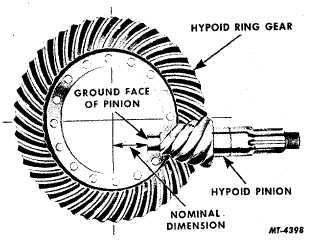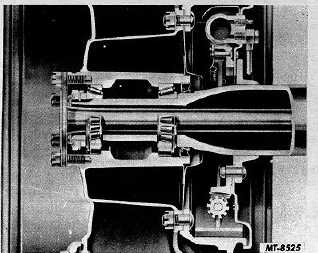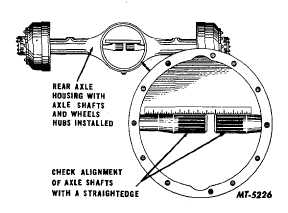|
| |
TRUCK SERVICE MANUAL
TM 5-4210-230-14&P-1
hypoid rear axles actually have a greater torque capacity than
do the spiral bevel type. This is possible because the hypoid
pinion is larger in diameter and has gear teeth that are larger
than those of the spiral bevel pinion having the same number
of teeth and same diameter ring gear. Hypoid pinions also
have larger tooth areas and more teeth in longer contact with
the ring gear. These design characteristics contribute to
greater strength and quieter final drive operation. However,
because of this greater tooth contact, more attention is
required when securing a correct pinion setting at time of
overhaul or when replacing differential bearings. Therefore,
every effort must be made to be sure the final setting results
in the best possible tooth contact.
Fig. 3 Hypoid Type Drive
Axle Shafts
Many axle failures can be attributed to the axle shafts;
therefore, it is most important that shafts be installed
correctly, be of correct size and length for splines to engage
fully, have wheel bearings adjusted properly, and be kept free
from runout or bends.
Fig. 4 illustrates the axle shaft and bearing arrangement on a
full-floating rear axle.
Axle Housing
In most cases the axle housing used for IH trucks is of one
piece construction with opening in center for mounting the
differential and carrier. The outer ends of the axle housing are
welded in place to provide mounting for the brake backing
plates. A bent axle housing can be the cause of early axle
failure, and whenever an axle is rebuilt, this condition should
always be checked before going ahead with the assembly.
Fig. 5 gives a quick way of checking for a bent housing.
Fig. 4 Cross Section of Full-Floating Rear Axle
Fig. 5 Method of Checking For Bent Axle Housing
REMOVAL PROCEDURES
Axle Assembly
Whether the complete axle assembly will have to be removed
from the truck for overhaul is determined by the extent of the
repairs required. For most axle repairs complete removal of
the axle will not be necessary; but in the event that it is,
removal procedure will be similar to the following:
1.
Jack up truck until load is removed from springs and
place blocks under frame to safety secure truck
weight off of rear wheels.
2.
Drain differential housing.
3.
Disconnect brake lines and parking brake cables
(where used).
CTS-2095S-CHAPTER I-Page 4
PRINTED IN UNITED STATES OF AMERICA
|



